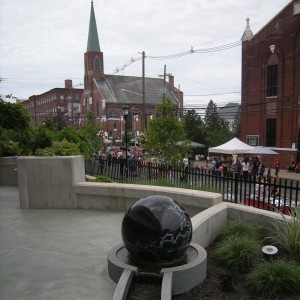On Saturday I went to the Hungarian Festival in New Brunswick, NJ. They closed off several blocks along Somerset Street, the old Hungarian neighborhood and set up booths, selling Hungarian cookbooks, stove cakes, “Kiss me I’m Hungarian” T-shirts, and paprika. Hungarian music filled the air. Adjacent to fair is the Children’s Specialized Hospital. I designed a therapy garden for the hospital that sits atop an auditorium roof and is visible from the street level. I ate some Peshane (pork and sauerkraut on rye) and a kielbasa sandwich. I didn’t have room for the stuffed cabbage and chicken paprikash.

View of Hungarian Festival from Therapy Garden
My grandparents were born in Hungary. My grandmother died before I was born and my father didn’t speak with his father, so after marrying my Irish mother, he never spoke Hungarian again. Therefore, I never learned the language. I did, however, grow up in a Hungarian and Polish neighborhood in Passaic, NJ. I attended the Hungarian Catholic Church as a kid and each summer my parents brought me to the church picnics. I would watch the couples dance to Hungarian folk songs; the men, with their hands on the woman’s waist and the women with their hands on the men’s shoulder. Although I haven’t been in touch with my ethnic roots for awhile, at the festival I did feel a sense connection with the people, like I belonged there.
Both Passaic and New Brunswick were established along major rivers, the Passaic and Raritan Rivers respectively. During the beginning of the twentieth century, when the industrial revolution was starting, factories sprung up along the rivers. The Hungarian and Polish immigrants came from Europe and were hired to work in the textile mills. They lived in homes and apartments around the factories. This is how the ethnic neighborhoods developed.
The factories in New Brunswick are now gone. They have been replaced by the corporate headquarter buildings of Johnson and Johnson Pharmaceuticals. Most of the Hungarian families are also gone. Many left when the factories closed. Others stayed until there children were grown and then followed them to start new jobs and families elsewhere. Now all that remains of the old neighborhood are , a deli, a bar, the old street with rundown houses, and the churches. There is one recent addition to the street, a beautiful new Hungarian Cultural Center built and paid for by the Children’s Specialized Hospital. The Cultural Center is the center of activity each year when the families return to the neighborhood to celebrate their heritage. The original Center was knocked down to make room for the new hospital. My therapy garden now stands where it used to be. The urban setting constantly changes over time but no matter what the physical makeup of the area, it is the people who make it a neighborhood.
